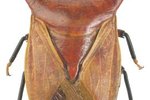
The sight of a skunk, with its ambling gait and recognizable bushy, black-and-white tail, is enough to send many people running in the opposite direction. Despite humans' wariness toward skunks, these animals have a high mortality rate in the wild, with between 50 and 70 percent of young skunks not living to see their second year.
Habitat
Skunks, which can be found all over the Americas, Indonesia and the Philippines, can live in a variety of habitats, including open forests, meadows or caves, but eschew dense forests and wetlands. During the day, skunks find shelter in dens, which they might burrow themselves or borrow from another creature. During the winter, skunks will remain in their dens amidst beds of leaves and grass, but warmer months may tempt them to make homes above ground in thickets of vegetation.
Diet
Wild skunks are omnivorous and spend much of their waking time foraging for food. While they prefer insects material such as larvae, skunks also will eat vegetation and small invertebrates.
Behavior
Wild skunks live solitary lives -- with the exception of mating season, which can last from two to three months, and during which a male skunk may seek out multiple females. They are not territorial animals and may breed with similar species. To communicate amongst one another, skunks use a variety of vocal signals, including grunts, growls and hisses, and typically do not display aggressive behavior unless threatened or ill with a disease such as rabies, to which skunks are particularly vulnerable.
Defensive Skills
Multiple larger animals prey on the skunk, including coyotes, foxes, American badgers, several types of big cats and large birds of prey such as eagles and great horned owls. Humans also pose a large threat to skunks by killing them off in order to control rabies. To protect itself and ward off predators, a skunk will first display a series of aggressive behaviors, including holding his tail erect, standing on his front paws and stomping his paws on the ground. If that fails, he will emit a foul-smelling substance from his anal glands: a sticky, fine mist of musk that will cause significant but impermanent eye irritation to his attacker.
References
Photo Credits
-
Jupiterimages/liquidlibrary/Getty Images
Writer Bio
Margot Freeman has been a writer since 2009. She currently works in social media within the tech industry, and has been volunteering with acclaimed Austin, Texas animal shelter Austin Pets Alive! since 2010. Freeman holds a Bachelor of science in audio and media technology.




